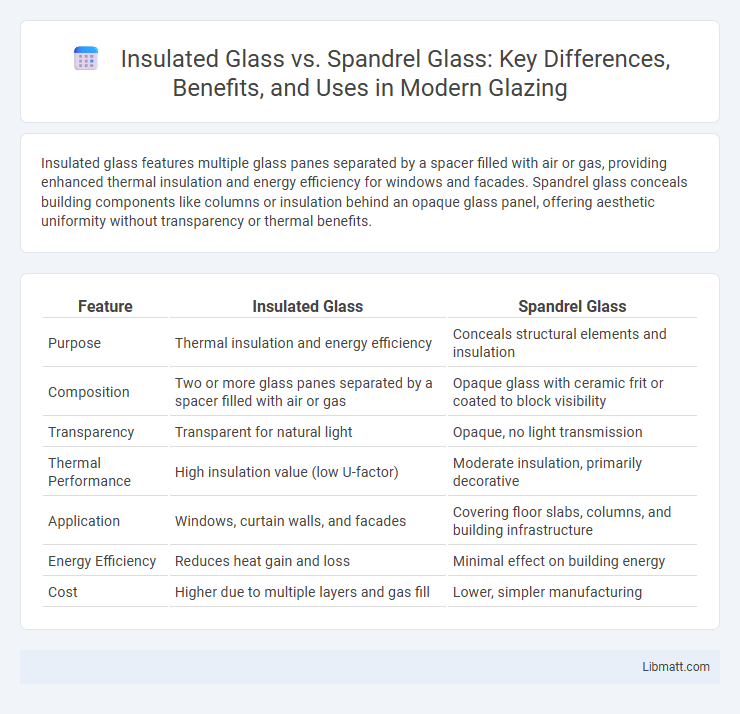Insulated glass features multiple glass panes separated by a spacer filled with air or gas, providing enhanced thermal insulation and energy efficiency for windows and facades. Spandrel glass conceals building components like columns or insulation behind an opaque glass panel, offering aesthetic uniformity without transparency or thermal benefits.
Table of Comparison
| Feature | Insulated Glass | Spandrel Glass |
|---|---|---|
| Purpose | Thermal insulation and energy efficiency | Conceals structural elements and insulation |
| Composition | Two or more glass panes separated by a spacer filled with air or gas | Opaque glass with ceramic frit or coated to block visibility |
| Transparency | Transparent for natural light | Opaque, no light transmission |
| Thermal Performance | High insulation value (low U-factor) | Moderate insulation, primarily decorative |
| Application | Windows, curtain walls, and facades | Covering floor slabs, columns, and building infrastructure |
| Energy Efficiency | Reduces heat gain and loss | Minimal effect on building energy |
| Cost | Higher due to multiple layers and gas fill | Lower, simpler manufacturing |
Introduction to Insulated Glass and Spandrel Glass
Insulated glass consists of two or more glass panes separated by a spacer and sealed to create a thermal barrier that enhances energy efficiency and sound insulation in buildings. Spandrel glass, typically opaque or translucent, is used to conceal structural elements, insulation, and mechanical systems in curtain wall facades without compromising the building's exterior aesthetics. Both insulated and spandrel glass play crucial roles in modern architecture, balancing performance with design requirements.
Key Differences Between Insulated and Spandrel Glass
Insulated glass consists of two or more glass panes separated by an air or gas-filled space, providing enhanced thermal insulation and energy efficiency for your building. Spandrel glass, in contrast, is typically opaque or coated to conceal building elements such as structural components, insulation, or mechanical systems, and does not offer insulating properties. The key difference lies in insulated glass's focus on temperature regulation and energy savings, while spandrel glass primarily serves aesthetic and functional purposes by hiding non-vision areas of the facade.
Energy Efficiency Comparison
Insulated glass offers superior energy efficiency by providing excellent thermal insulation through multiple glass layers and gas fills, reducing heat transfer and lowering your heating and cooling costs. Spandrel glass, typically opaque and used for concealing building elements, contributes less to energy savings and primarily serves aesthetic and functional purposes rather than insulation. Choosing insulated glass enhances your building's overall energy performance and supports sustainable design goals.
Thermal Performance and Insulation Properties
Insulated glass offers superior thermal performance by incorporating multiple glass panes separated by a gas-filled space, significantly reducing heat transfer and enhancing energy efficiency. Spandrel glass, while primarily used for concealing structural elements, provides limited insulation as it typically consists of a single layer with insulating backing materials but lacks the comprehensive thermal barrier found in insulated glass. For optimal temperature regulation and energy savings in your building, choosing insulated glass ensures improved insulation properties compared to spandrel glass.
Aesthetic Applications in Modern Architecture
Insulated glass enhances modern architecture with its transparent, energy-efficient qualities, providing clear views and natural light in facades and windows. Spandrel glass offers sleek, opaque surfaces that conceal structural elements and mechanical systems, creating seamless, uniform building exteriors. Your design can balance both by using insulated glass for visibility and spandrel glass for aesthetic continuity and privacy.
Light Transmission and Opacity
Insulated glass offers high light transmission, making it ideal for spaces where natural daylight is a priority, while spandrel glass provides opacity to conceal building elements like structural components or mechanical systems. Your choice between these glass types depends on whether you need transparency or visual masking in your architectural design. Insulated glass enhances energy efficiency and clarity, whereas spandrel glass ensures privacy and aesthetic uniformity without compromising exterior appearance.
Structural and Safety Considerations
Insulated glass consists of two or more glass panes separated by a spacer and sealed to improve thermal performance and prevent condensation, providing enhanced durability and impact resistance. Spandrel glass is typically opaque and used to cover building elements like columns or mechanical systems, often reinforced with a backing material to ensure structural stability without transparency. When considering safety, insulated glass units are laminated or tempered to reduce breakage risk, while spandrel glass's material composition and installation methods prioritize fire resistance and structural integrity in non-vision areas.
Cost Analysis: Insulated vs Spandrel Glass
Insulated glass typically costs more upfront due to its dual-pane construction with gas fills and low-emissivity coatings designed for thermal efficiency, whereas spandrel glass is generally less expensive, primarily serving as an opaque, decorative panel with a single-layer or coated surface. Maintenance and energy savings with insulated glass can lead to lower long-term costs, offsetting its initial premium when compared to spandrel glass. For projects prioritizing energy efficiency, insulated glass offers better return on investment despite higher initial costs, while spandrel glass remains cost-effective for non-vision areas focused on aesthetic and concealment purposes.
Suitable Use Cases and Installation Options
Insulated glass is ideal for energy-efficient windows and doors where thermal insulation and sound reduction are critical, commonly used in residential and commercial buildings. Spandrel glass serves as a non-transparent component in curtain walls, concealing structural elements and insulation while providing a uniform exterior facade. Installation of insulated glass involves framing within window sashes or panels with sealants to maintain airtightness, whereas spandrel glass is typically installed as part of the building envelope, often requiring custom panels to match the architectural design and cover mechanical and structural systems.
Choosing the Right Glass for Your Project
Insulated glass offers superior thermal performance and energy efficiency, making it ideal for projects requiring temperature control and sound insulation. Spandrel glass, often used for concealing structural elements, provides a sleek exterior appearance without transparency. Your choice depends on whether your priority is insulation and visibility or aesthetic uniformity and hiding building components.
insulated glass vs spandrel glass Infographic

 libmatt.com
libmatt.com